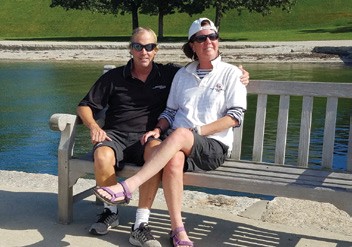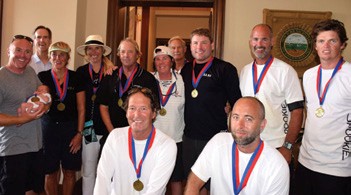By Stuart Streuli, New York Yacht Club Communications Director
 In becoming the first female skipper to win the Queen’s Cup, one of the New York Yacht Club’s most prestigious yachting trophies, Heidi Benjamin of South Norwalk, CT relied on her yacht, her crew and two distinct sources of inspiration.
In becoming the first female skipper to win the Queen’s Cup, one of the New York Yacht Club’s most prestigious yachting trophies, Heidi Benjamin of South Norwalk, CT relied on her yacht, her crew and two distinct sources of inspiration.
Benj & Heidi share a quiet moment at Harbour Court after the day’s competition.
The first was no surprise to anyone who knows Benjamin and her family’s long association with sailing. “My dad, Bill Ziegler, used to tell me how much he wanted to win the Queen’s Cup,” said Benjamin, noting that despite much success with a number of boats named Gem, her late father was never able to put his name on the Queen’s Cup. “This one is for him.”
The second was a ladybug that landed on her shirt before the race started on Sunday, August 14 off the coast of Newport, RI. Benjamin said that whenever she started to feel anxious about filling the shoes of the boat’s usual skipper, husband Steve Benjamin, the 1984 Olympic silver medalist in the 470 class and the 2015 Rolex Yachtsman of the Year, she thought about this tiny beetle calmly resting on her shirt, and it helped restore her peace of mind.
The Queen’s Cup, hosted by the NYYC’s Harbour Court, is a unique event in modern sailing for a variety of reasons. The starting gun opens a two-minute window for all boats to cross the starting line. The race committee takes each yacht’s starting time as it crosses the line and uses that to calculate its elapsed time for the race. Second, the regatta is just one race, not the usual multi-race events that allow time to compensate for the occasional mistake. And finally, to do justice to the variety of yachts that compete in the Queen’s Cup, the race committee traditionally uses a mix of triangle and windward/leeward laps to build the course.
Taken separately, and in the absence of competitive pressure, none of these components are technically complex. But, in real time, while racing in 15-knot southwesterly breeze with 8-foot seas, they can present significant challenges.
“I had my longtime friend, Peter Isler (who taught me how to sail) and my wonderful husband by me through the Queen’s Cup,” said Benjamin.
 “There was a lot of discussion on the boat about starting a little bit late and coming in at the windward end,” said Steve Benjamin, who played the role of on-board coach for the day, with America’s Cup veteran and former college teammate Peter Isler calling tactics. “I was really nervous about any kind of a port-tack approach with all those starboard tackers.”
“There was a lot of discussion on the boat about starting a little bit late and coming in at the windward end,” said Steve Benjamin, who played the role of on-board coach for the day, with America’s Cup veteran and former college teammate Peter Isler calling tactics. “I was really nervous about any kind of a port-tack approach with all those starboard tackers.”
The crew of Spookie celebrates their Queen’s Cup victory. © Stuart Streuli/NYYC
As one of the fastest boats in the fleet, however, the allure of getting out in front and sailing in clean air for the entire race was too much. The 52-foot Spookie crossed the line a single second after the starting gun and led the 15-boat fleet around the 12-mile racecourse. “Benj and I have sailed together for nearly 30 years,” said Benjamin, “resulting in our ability to share similar strategies on the racecourse. Sailing has always been a family sport for Benj and me growing up. We try to foster this sentiment in our crew.”
While the clean course was an advantage for Spookie, it was far from a runaway victory. Interlodge, the 44-footer owned by Austin and Gwen Fragomen, kept pace with Spookie all the way around the course. Once both yachts’ times were corrected based on the handicaps carried by each, the winning margin was just 14 seconds – about two boat lengths, not a lot of room for error in a race that took nearly and hour and a quarter for the fastest boats to complete.
The remainder of the fleet trickled in over the course of 25 minutes and while many boats had a significant advantage according to the IRC ratings, none could come close to Spookie’s corrected time. In third place was the Swan 42 Blazer, skippered by Chris Culver, which finished just 5 seconds in front of Dennis Williams’ 12 Metre Victory ‘83, and 54 seconds ahead of John Hele’s Daring, another Swan 42. “The hard work and dedication of the crew to each other and the program is reflected in the teamwork which helps us to achieve the results we all work so hard for,” said an elated Benjamin.
The Queen’s Cup was given to the New York Yacht Club by Queen Elizabeth II of England. It was formally presented by the British Ambassador at the Annual Cruise dinner in November 1953. The former King’s Cup (raced for annually from 1906 through 1952) was retired and is retained by the club. The Queen’s Cup is a perpetual trophy to be raced for annually under the same conditions at the preceding King’s Cup races. For this year’s results and a notable list of past winners, visit nyyc.org/yachting/racing/2016-queens-cup.




